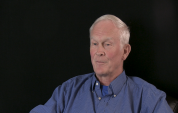5:55 | The ARVN battalion was on the top of the hill and the NVA were swarming up. Forward air controller Tom Fleming describes the incredible scene of carnage when AC-130 gunships arrived and stopped the horde. He contrasts the bravery and commitment of the enemy with the mindset of the southern troops.
Keywords : Tom Fleming Forward Air Controller (FAC) Vietnam North Vietnamese Army (NVA) Lockheed AC-130H (Spectre) South Vietnamese Lam Son 719

With one eye on the space race and one eye on Vietnam, Tom Fleming started his military career as the battalion commander of his high school ROTC. He got an appointment to the Air Force Academy, where he earned a private pilots license in between the hazing.
They drew lots at the Air Force Academy to pick your training base. Tom Fleming got a lousy number and was left with a new, obscure base in Mississippi. No one had wanted it but it turned out to be an ideal location. Like everyone, he wanted to be a fighter pilot, and after learning to fly a succession of trainers, he angled for a slot.
After a short stop in the Philippines for survival training, Tom Fleming flew to Cam Ranh Bay to get his assignment as a forward air controller. He found out he would be based in Thailand and flying missions over Laos. The goal was to disrupt traffic on the Ho Chi Minh Trail.
It was a night war over Laos. The enemy didn't move much during the day, so the sky was full of action during the night. Forward air controller Tom Fleming describes how he marked targets for strikes by fighters.
At some point in Tom Fleming's Vietnam tour, he began doing check rides for new pilots assigned to his FAC squadron. He went for a wild ride when one new guy saw his first anti-aircraft fire. When anyone was shot down, everything else stopped while every effort was made to recover them.
Operation Lam Son 719 was a joint operation involving South Vietnamese troops and American air power. The goal was to advance into Laos, where US troops were forbidden to operate, and execute a pre-emptive strike on the enemy who were planning an offensive. It did not go well, as recalled by forward air controller Tom Fleming.
He flew almost every day but, thankfully, the missions were fairly short. There were day and night missions and everyone rotated through the schedule. Tom Fleming was a FAC based in Thailand and that was fortunate for him when it came to the living conditions.
He got shot at a lot. On night missions the tracers revealed what weapons were targeting FAC Tom Fleming. He was based in Thailand and his missions were over Laos, where the objective was to disrupt traffic on the Ho Chi Minh Trail. The anti-aircraft fire wasn't his greatest fear. It was friendly fire and collisions with other US aircraft.
Forward Air Controller Tom Fleming had a very unusual mission which convinced him we had nuked Laos. He was paired with a C-130 but the pilot in the other plane would not divulge what was going on. Then he saw a large object with a parachute being pushed out the back of the big plane.
Was the war in Vietnam a mistake? Tom Fleming was there and he believes it was important to show the large communist powers that we would not let their efforts around the world go unchecked. There were massive problems with the management of that war, for sure, but we needed to be there and could have easily had a different outcome.
From the beginning, Tom Fleming wanted to be a fighter pilot. He settled for a tour as a forward air controller in Vietnam and, after that, his quest for fighters continued as he embarked on a lengthy Air Force career. That career took him to Turkey, Germany, many stateside bases and the Pentagon, but it was Hawaii that was most satisfactory.
As Operation Desert Shield gave way to Operation Desert Storm, the Pentagon needed someone like a fighter pilot to brief the Joint Chiefs and the Secretary of Defense on biological and chemical warfare in language they could understand. So, Tom Fleming became the "bugs and gas guy."